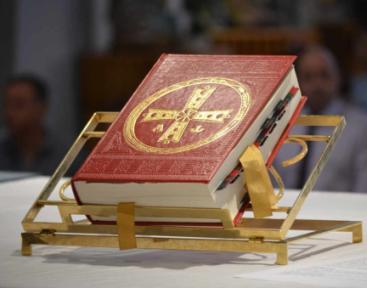

Q. 1. What is the purpose of the Roman Missal?
A. 1. The Roman Missal (Latin: Missale Romanum) is the liturgical book that contains the texts and rubrics for the celebration of the Mass in the Roman Rite of the Catholic Church.
Note: The liturgical books of the Roman Rite are officially issued books that contain the words of the prayers to be recited and indicate the actions to be performed in the celebration of the Catholic liturgy as done in Rome. To the titles of some of these books, the adjective "Roman" is attached, so as to distinguish them from the liturgical books intended for use in other liturgical rites. An example is the "Roman Missal".
Note: Instructions for a priest explaining what he must do during a liturgy were also rubricated in missals and the other liturgical books, and the texts to be spoken aloud were in black. From this, "rubric" has a secondary denotation of an instruction in a text, regardless of how it is actually inscribed.
[Source: https://en.wikipedia.org/wiki/Roman_Missal]
The "1570 Roman Missal" versus the "Novus Ordo Missae"
The Tridentine Mass, the 1962 version of which has been officially declared the (authorized) extraordinary form of the Roman Rite of Mass (Extraordinary Form for short; Latin: forma extraordinaria), is the Roman Rite Mass which appears in typical editions of the Roman Missal published from 1570 to 1962. The most widely used Mass liturgy in the world until the introduction of the Mass of Paul VI in 1969, it is celebrated in ecclesiastical Latin.
"Tridentine" is derived from the Latin Tridentinus, "related to the city of Tridentum" (modern-day Trent, Italy), where the Council of Trent was held. In response to a decision of that council, Pope Pius V promulgated the 1570 Roman Missal, making it mandatory throughout the Latin Church, except in places and religious orders with missals from before 1370. Despite being often described as "the (Traditional) Latin Mass", the Mass of Paul VI (the Novus Ordo Missae) that replaced it as the Ordinary Form of the Roman Rite has its official text in Latin and is sometimes celebrated in that language.
In 2007, Pope Benedict XVI issued the motu proprio Summorum Pontificum, accompanied by a letter to the world's bishops, authorizing use of the 1962 Tridentine Mass by all Latin Rite Catholic priests in Masses celebrated without the people. These Masses "may — observing all the norms of law — also be attended by faithful who, of their own free will, ask to be admitted".[7] Permission for competent priests to use the Tridentine Mass as parish liturgies may be given by the pastor or rector.
Benedict stated that the 1962 edition of the Roman Missal is to be considered an "extraordinary form" (forma extraordinaria) of the Roman Rite, of which the 1970 Mass of Paul VI is the ordinary, normal or standard form. Since that is the only authorized extraordinary form, some refer to the 1962 Tridentine Mass as "the extraordinary form" of the Mass. The 1962 Tridentine Mass is sometimes referred to as the "usus antiquior" (older use) or "forma antiquior" (older form), to differentiate it from the Mass of Paul VI, again in the sense of being the only one of the older forms for which authorization has been granted.
[Source: https://en.wikipedia.org/wiki/Tridentine_Mass]